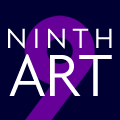>> Top Nine: O'Brien's Choice
>> Article 10: Arts From Their Elbows
More...

We don't get the CMX books over here in Britain, presumably because DC don't hold the foreign reprints rights for this country. In a roundabout way, this must be good news for British fans of slightly dubious comics, since it leaves open the possibility that an unedited edition of Oh Great's TENJHO TENGE might yet appear in the United Kingdom.
Sadly, Amazon UK does not list a UK edition at present (although for some strange reason it lists the American editions and claims they're out of print). Come on, British publishers! There's a whole teen market just waiting to be enticed into comics by the promise of sexual violence!
Well, okay, perhaps not. This whole fiasco raises some very odd questions about DC's judgment, not least of which is what could have possessed them to think that TENJHO TENGE was a suitable comic for children aged 13. Strictly speaking, it probably doesn't qualify as pornography. After all, it does have a plot. And the plot isn't about sex. It's about violence, which is much better. Nonetheless, the book has lavish quantities of sex, much of it violent, including a rape scene in the first volume.
Later volumes seem to get truly bizarre, and disappear off into the realms of sado-masochist fantasy. God only knows what's going on in this panel from volume 10 (caution: really, really not suitable for children, or for the office). Whatever it is, it looks dreadfully uncomfortable.
'The TENJHO TENGE fiasco raises some questions about DC's judgment.' Now, American manga publishers often face the dilemma that the Japanese have rather more relaxed standards than they do, and the Japanese idea of what's suitable for a young teenage audience might not match American views on the subject. In particular, it might not match the views of prosecutors in the Deep South. Despite its laudable commitment to free speech, the American mainstream is remarkably conservative by western standards. This has produced a bizarre situation where America produces the sort of pornography that would never get into Britain in a million years, yet runs its mainstream media by standards that seem positively puritan to British eyes.
Against this background, there will be circumstances where an American publisher faces the choice between toning down an imported comic, or leaving it as it is and effectively preventing it from reaching its intended audience. In such cases there can be an argument for editing. The edited version may not be authentic, but sometimes the more restrained version may actually work better for an audience operating under different cultural standards.
TENJHO TENGE is not such a comic, save perhaps to the extent that some editing might have been necessary to stop the cops hauling later volumes off the shelves altogether. Leaving that aside, when DC were considering it as an American publication, they had two basic options. Option one, licence it and publish it as an adult comic. CMX does publish mature-readers books, after all. Option two, shudder in disgust and desire not to bother with it.
Instead, DC have gone for an unfathomable third option ? licence it, edit it heavily, and publish it with a "teen" rating.
'The Japanese have rather more relaxed standards than the Americans.' Heaven only knows what was going through DC's mind when they came up with that idea. Some of the material in later volumes is blatantly not suitable for selling to 13-year-old audiences, at least if you don't want a visit from the local prosecutor. Even volume one, which is apparently considered fairly tame, required more than a little editing. Fans have identified 36 separate edits, mostly along the lines of adding bras, cropping panels, and obscuring naughty bits with sound effects.
Complaints about the quality of the edits do seem to have some merit to them. I was unaware that "LEAP" constituted a sound effect, but apparently it was the best anyone could come up with to cover an up-skirt shot on page 50. It's horribly amateurish. Page 86 looks decidedly like a sex scene in the original, but CMX have thoughtfully provided the characters with some extra clothes. At that point you're changing the meaning of scenes. They may not have been very good scenes to start with, but if you're taking that view, why licence the thing at all?
CMX advertises its material as "pure manga ? 100% the way the original Japanese creators want you to see it". This has the faint whiff of a slogan that was coined by an editor and then carefully revised by the legal department. You'll note that the promise is to deliver the comics the way the creators want you ? that's American readers ? to see it. It's not a promise to deliver the comics in the form in which they were originally published, although it's carefully phrased to look like one at first glance. In practice, it seems to mean nothing more than that the original creator has signed off on the changes.
And, as I say, in some cases that may be reasonable; hardcore fans might prefer to see an absolutely accurate reprint, but in a more conservative country like America, a minor edit or two may be the most practical way of making sure the book reaches its target audience rather than being banished to an audience of hardcore fans ten years older than the creator was trying to reach. In this case, however, CMX have really taken the scissors to the book, in order to make it suitable for an audience who weren't even the original target.
''Pure manga ? 100% the way the original Japanese creators want you to see it.'' In fact, creator Oh Great (which I can only imagine sounds awfully cool if you're Japanese, in much the same way that random Japanese syllables do to us dumb westerners) has signed off on the changes. Given their nature, this seems a little surprising, but hey, it's his comic. As future volumes get increasingly explicit, it'll be amusing to see how desperate the editing becomes, and how much of a razoring Oh Great is prepared to sign off on. We're already in the slightly odd position where the fans are complaining about edits that the creator was perfectly happy to approve; and even odder, the fans' position seems easier to understand than the creator's.
I'm not exactly inclined to join any campaigns for publication of the unedited comic, which, to be honest, sounds a bit on the sleazy side. Still, the whole affair seems a remarkable cock-up on DC's part. If they knew what was in future volumes, how on Earth could they have decided that the book was suitable for a teen audience ? no matter how heavily trimmed? If they didn't, then why on Earth not? And when the nascent CMX imprint, a latecomer to the market, which needs all the help it can get, is trying to stake itself out as a purveyor of 100% authentic manga, why on Earth invite criticism from the very audience they're trying to reach by publishing anything in such a heavily edited form?
By editing volume one so heavily, CMX has sent a clear message that the (shall we say) racier future volumes will be cut to smithereens. It doesn't take a genius to see that this is no way to win over the manga audience. But then, somebody somewhere hasn't been thinking this through at all.

This article is Ideological Freeware. The author grants permission for its reproduction and redistribution by private individuals on condition that the author and source of the article are clearly shown, no charge is made, and the whole article is reproduced intact, including this notice.


